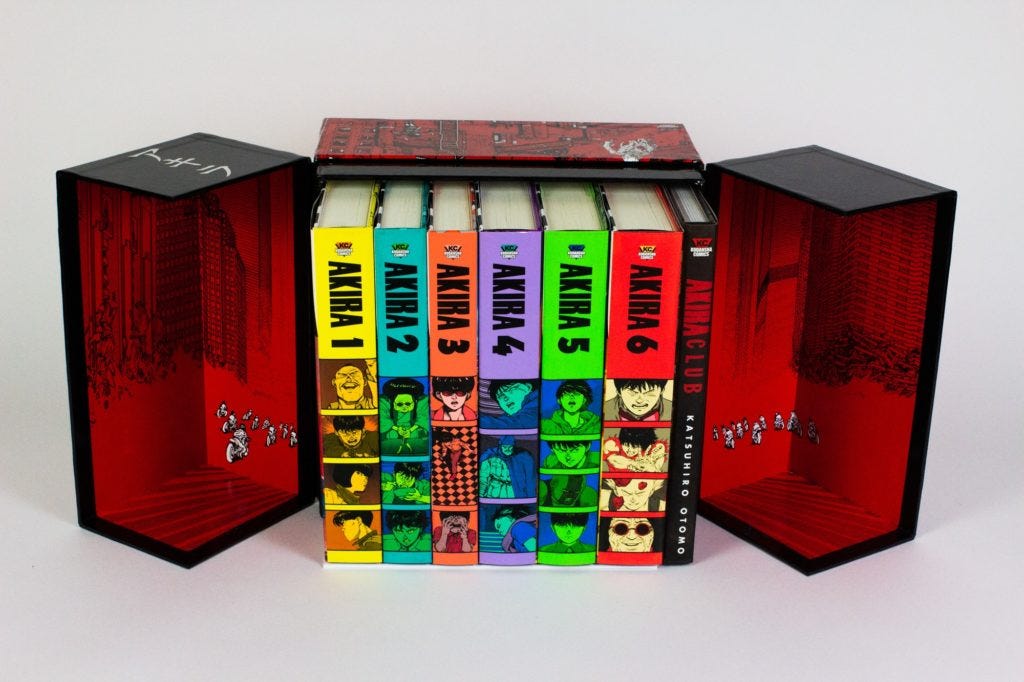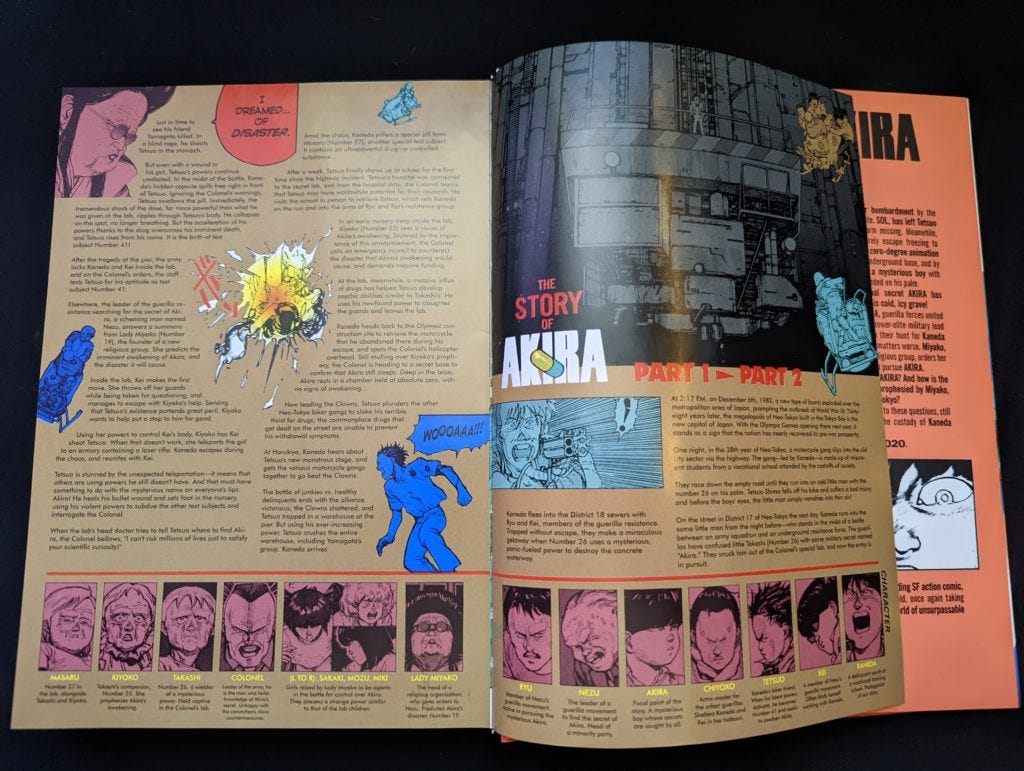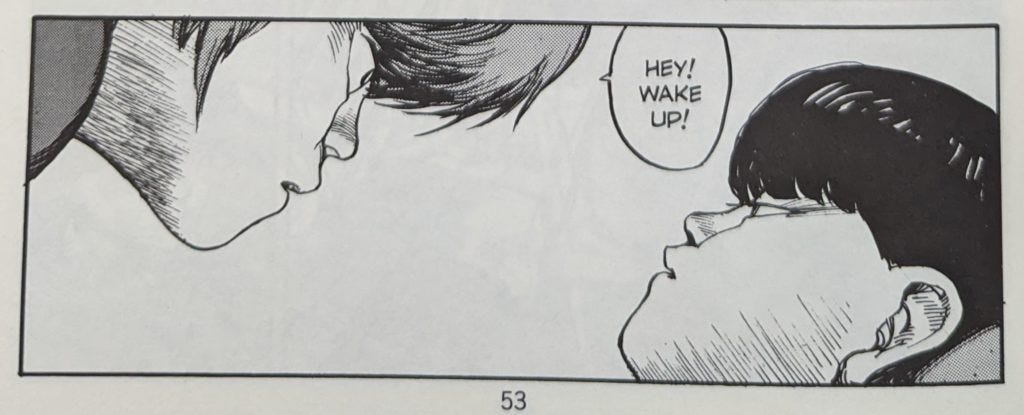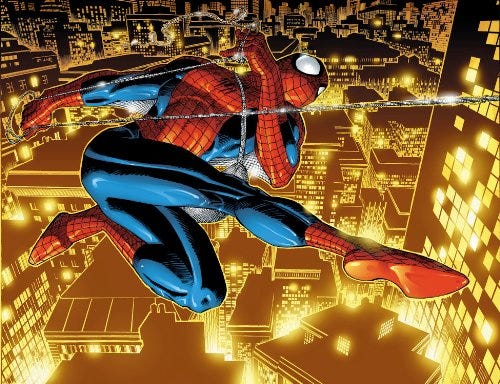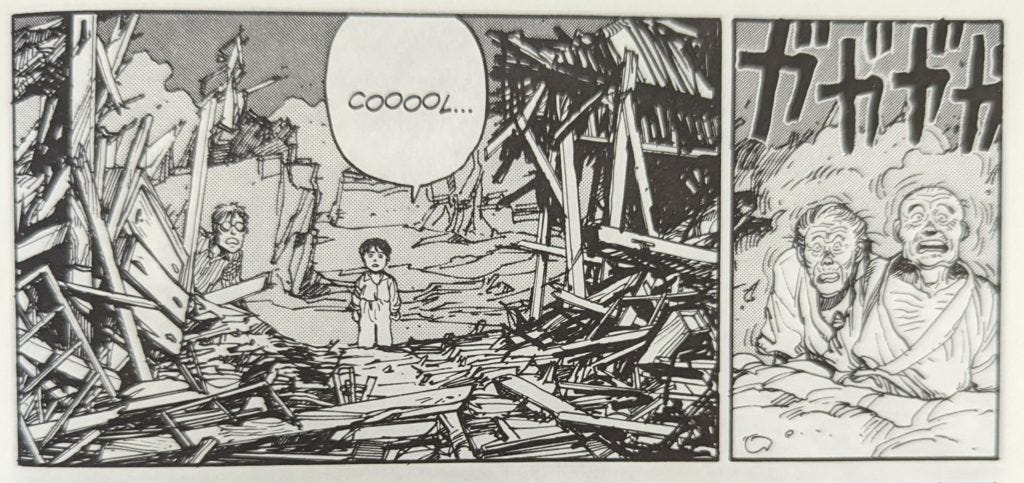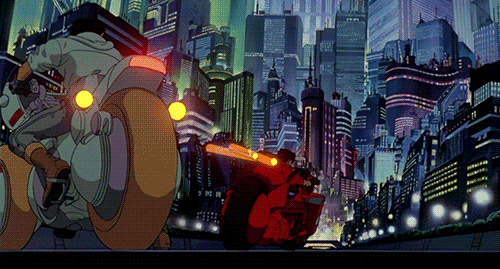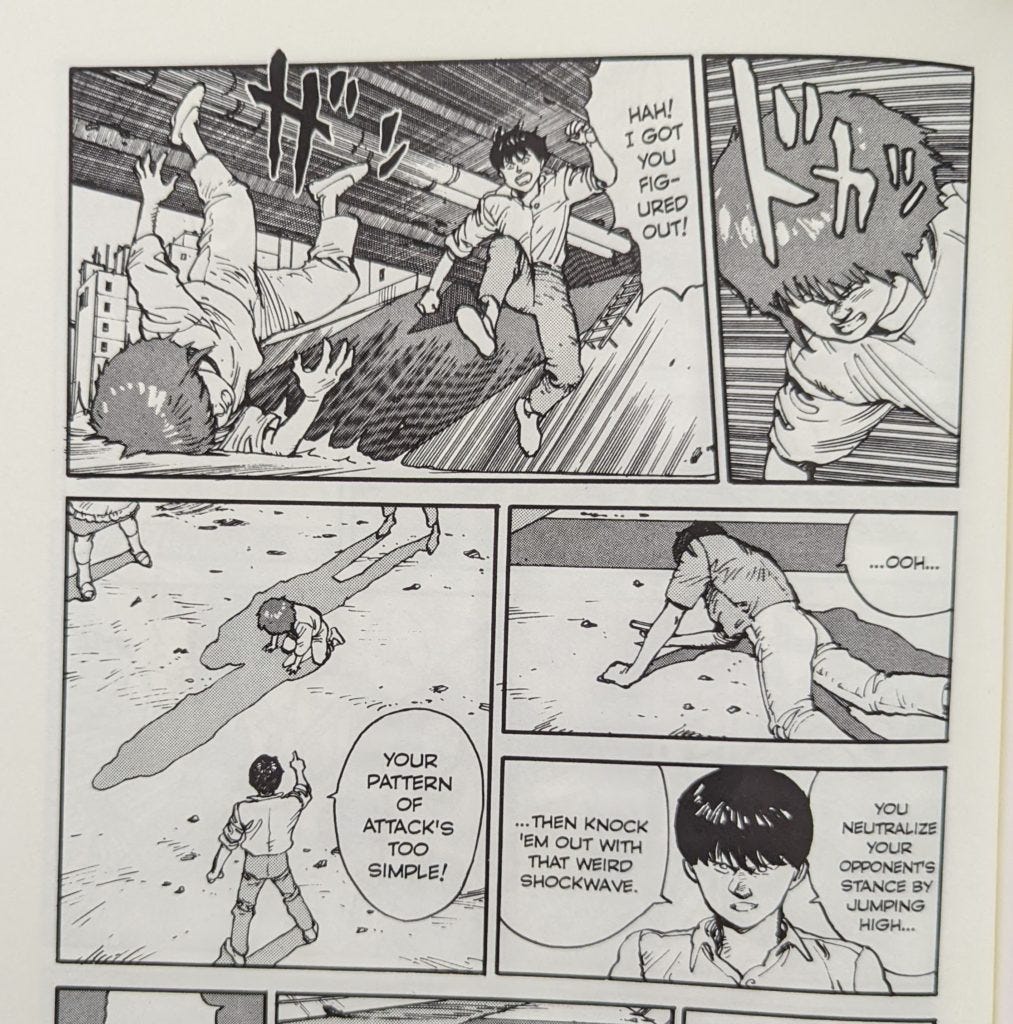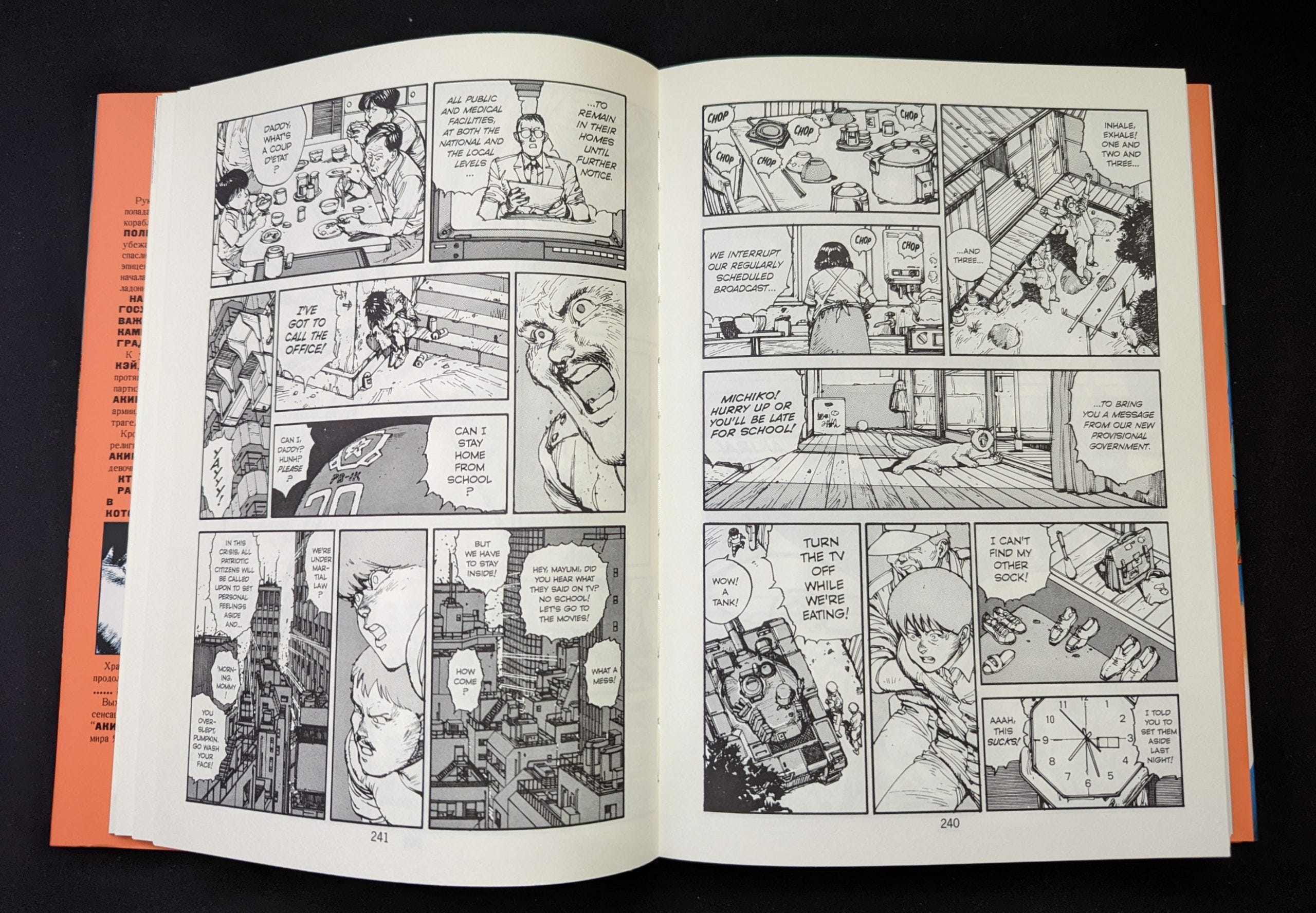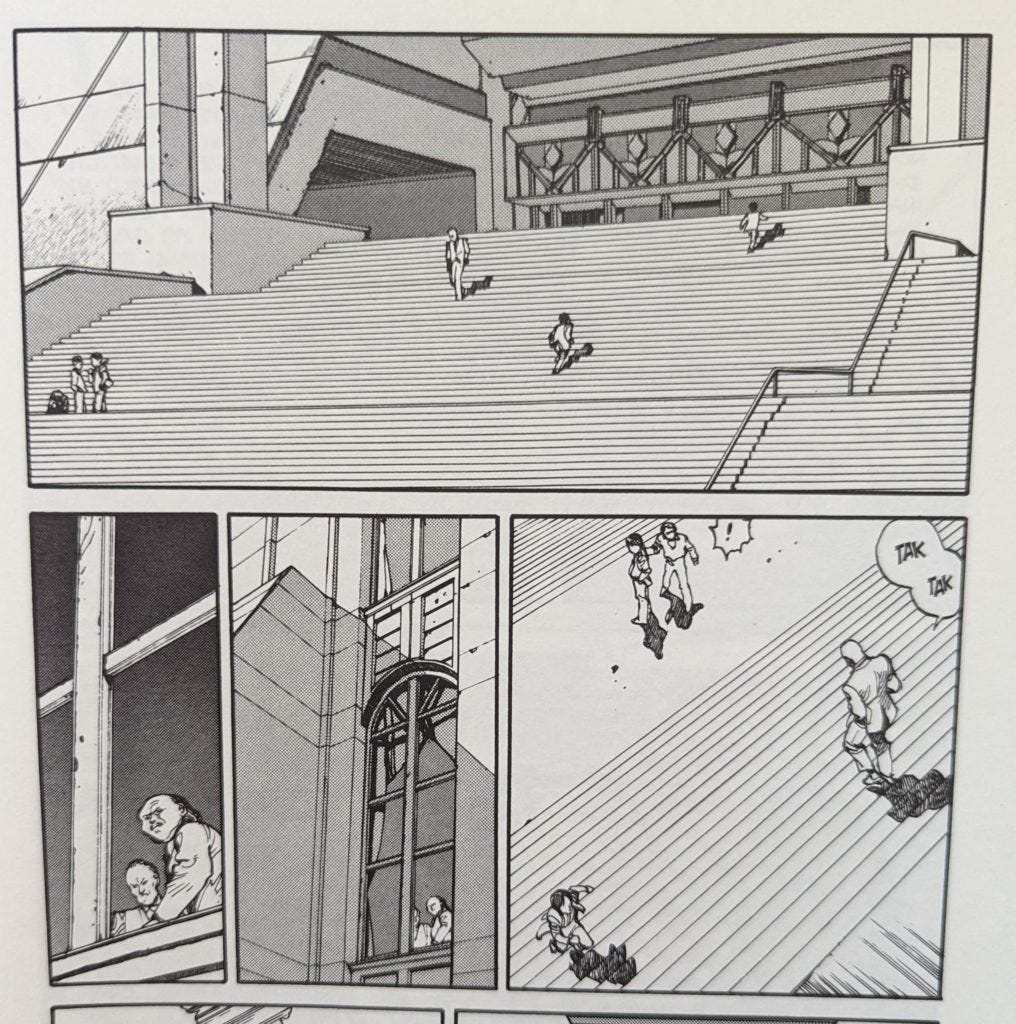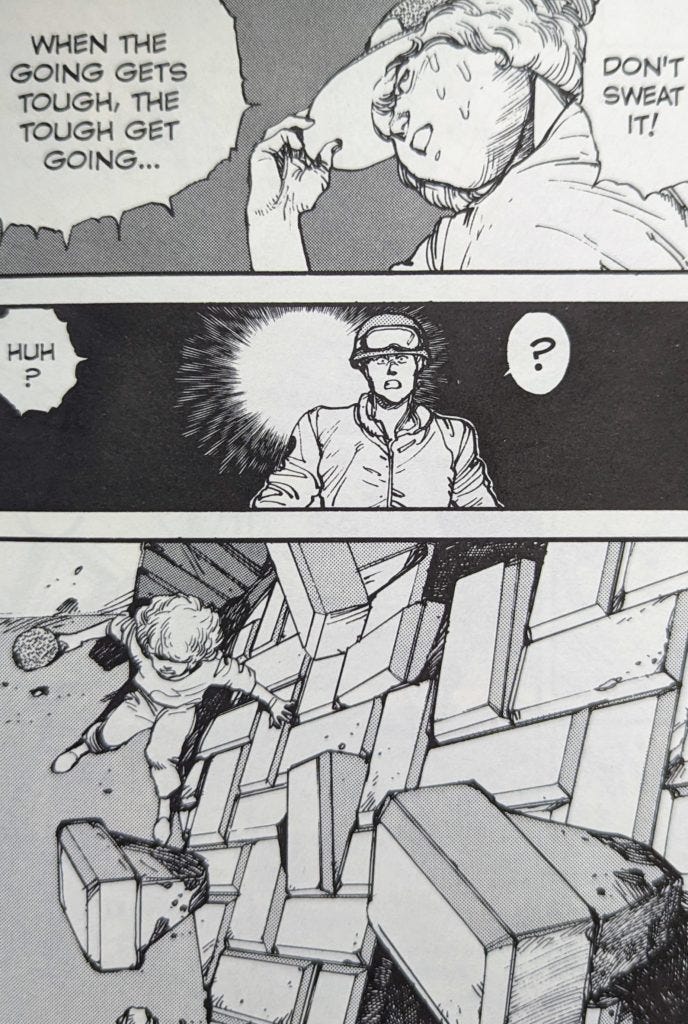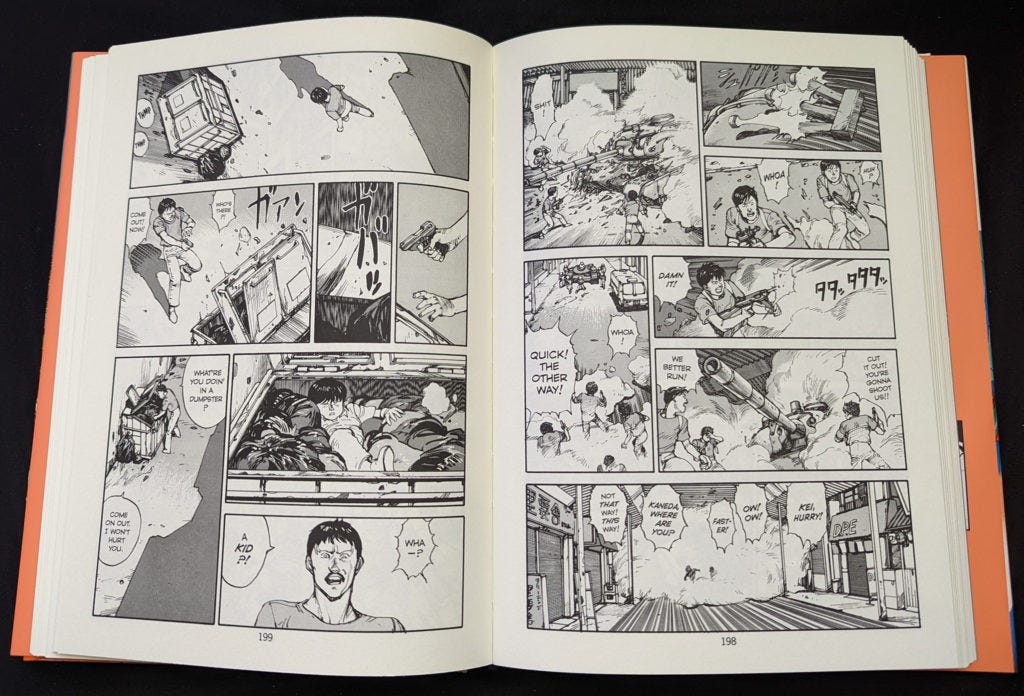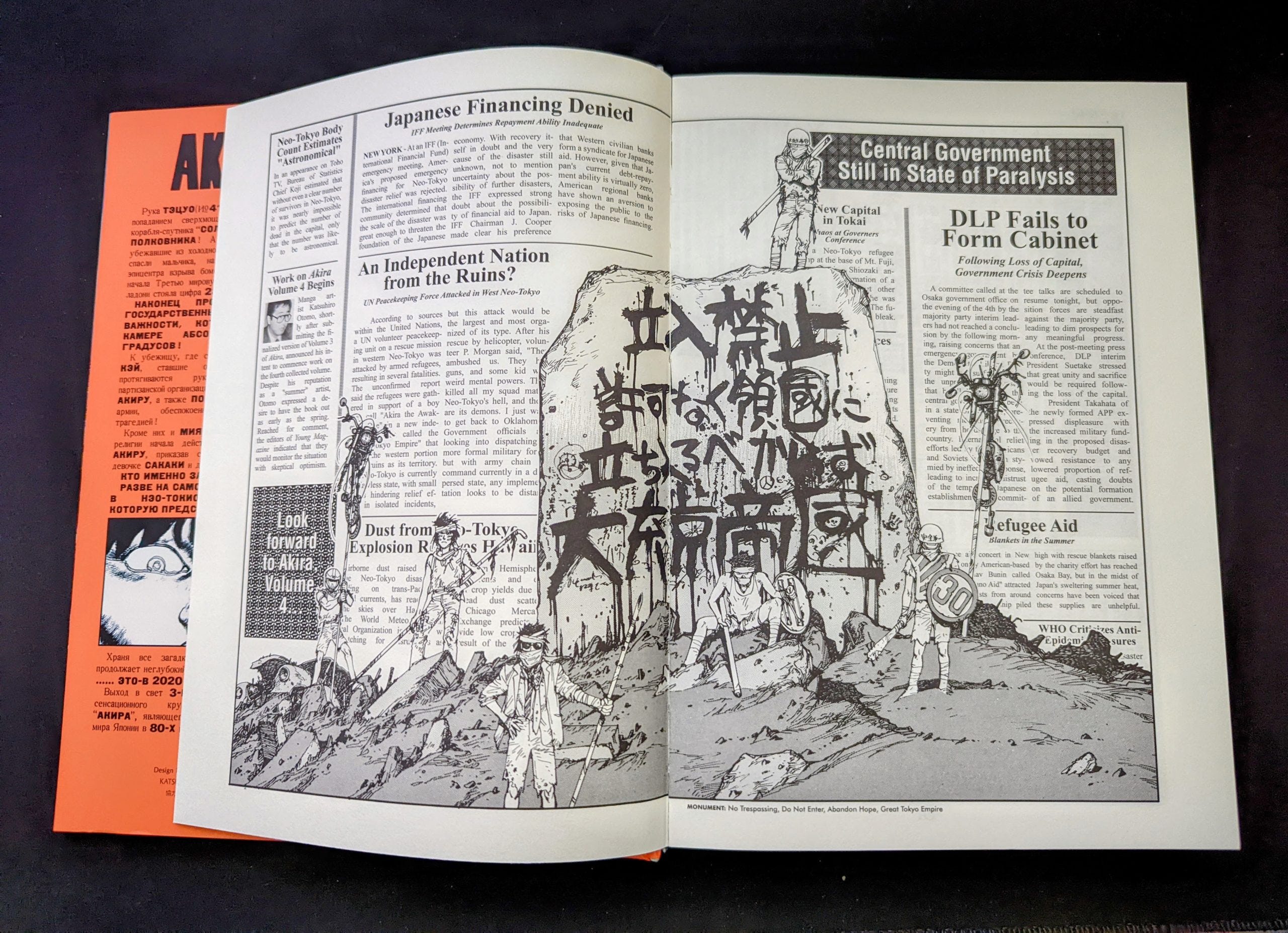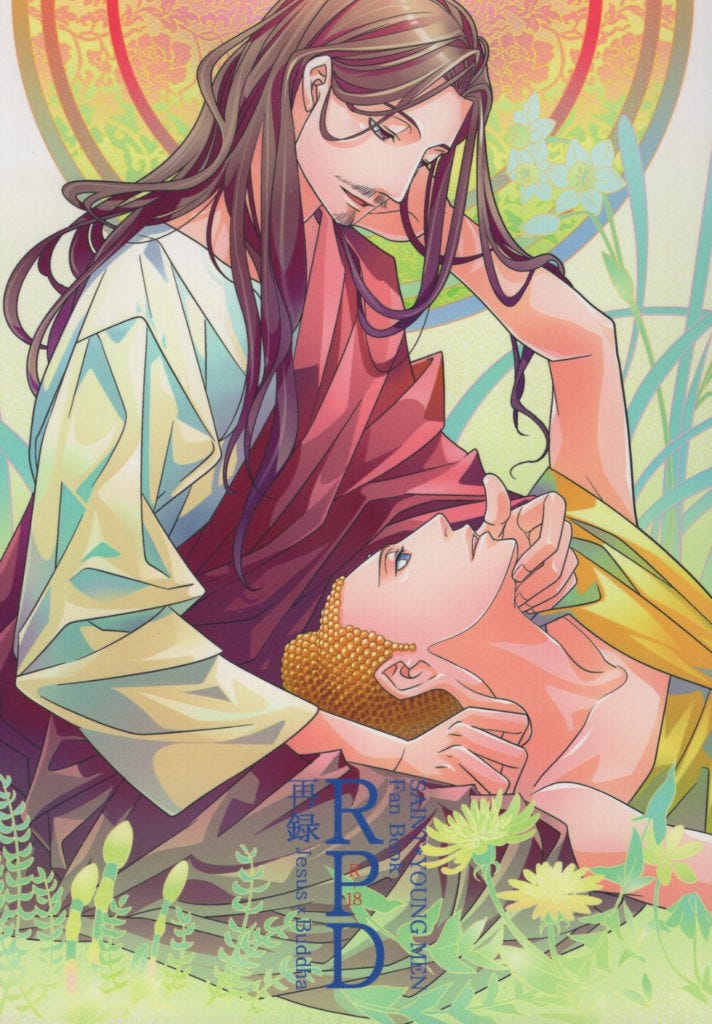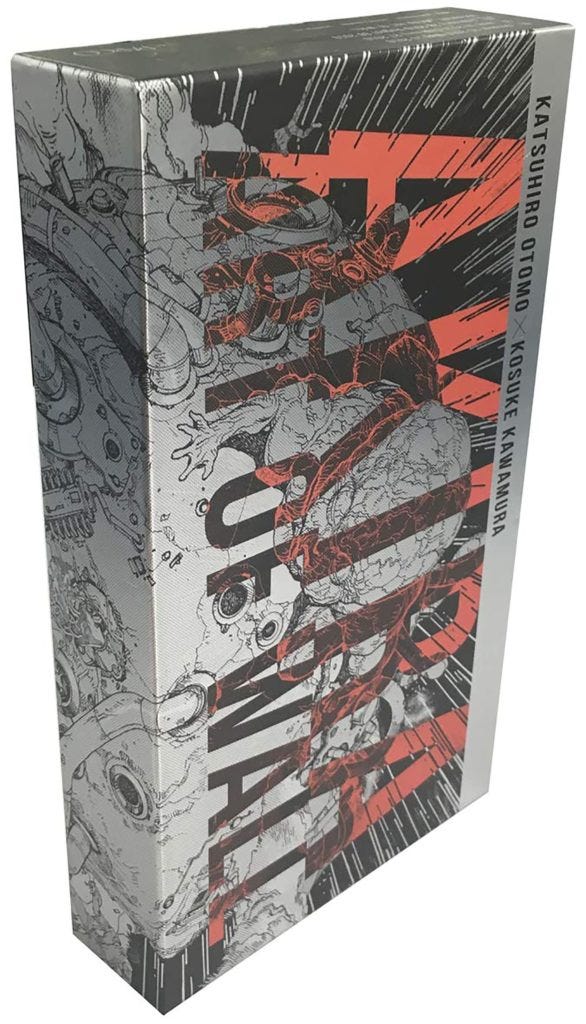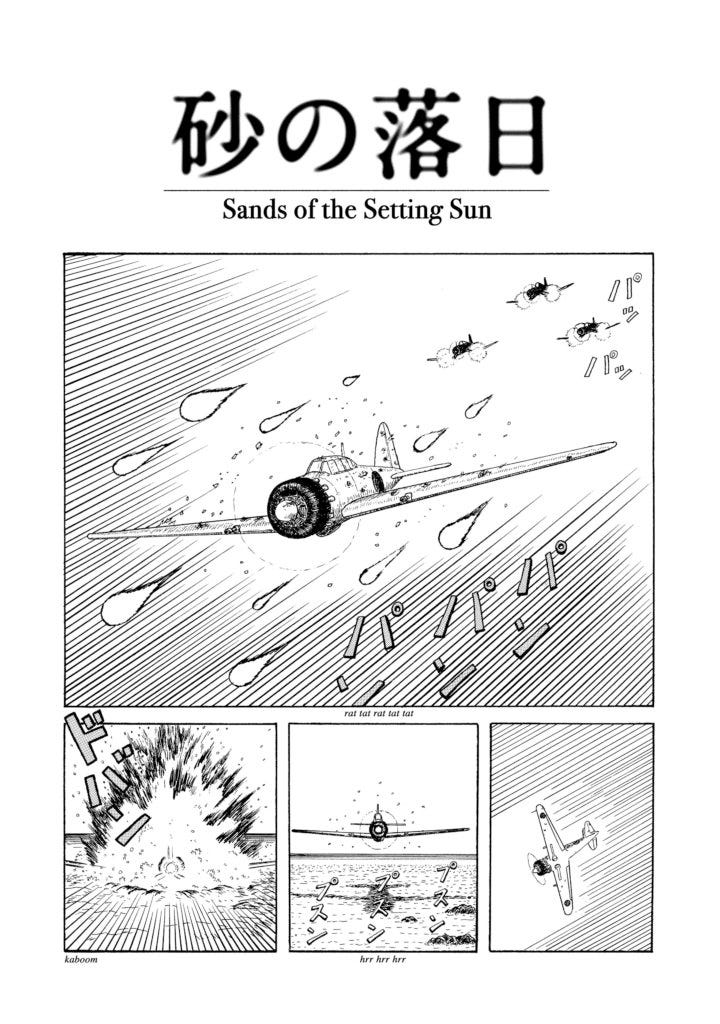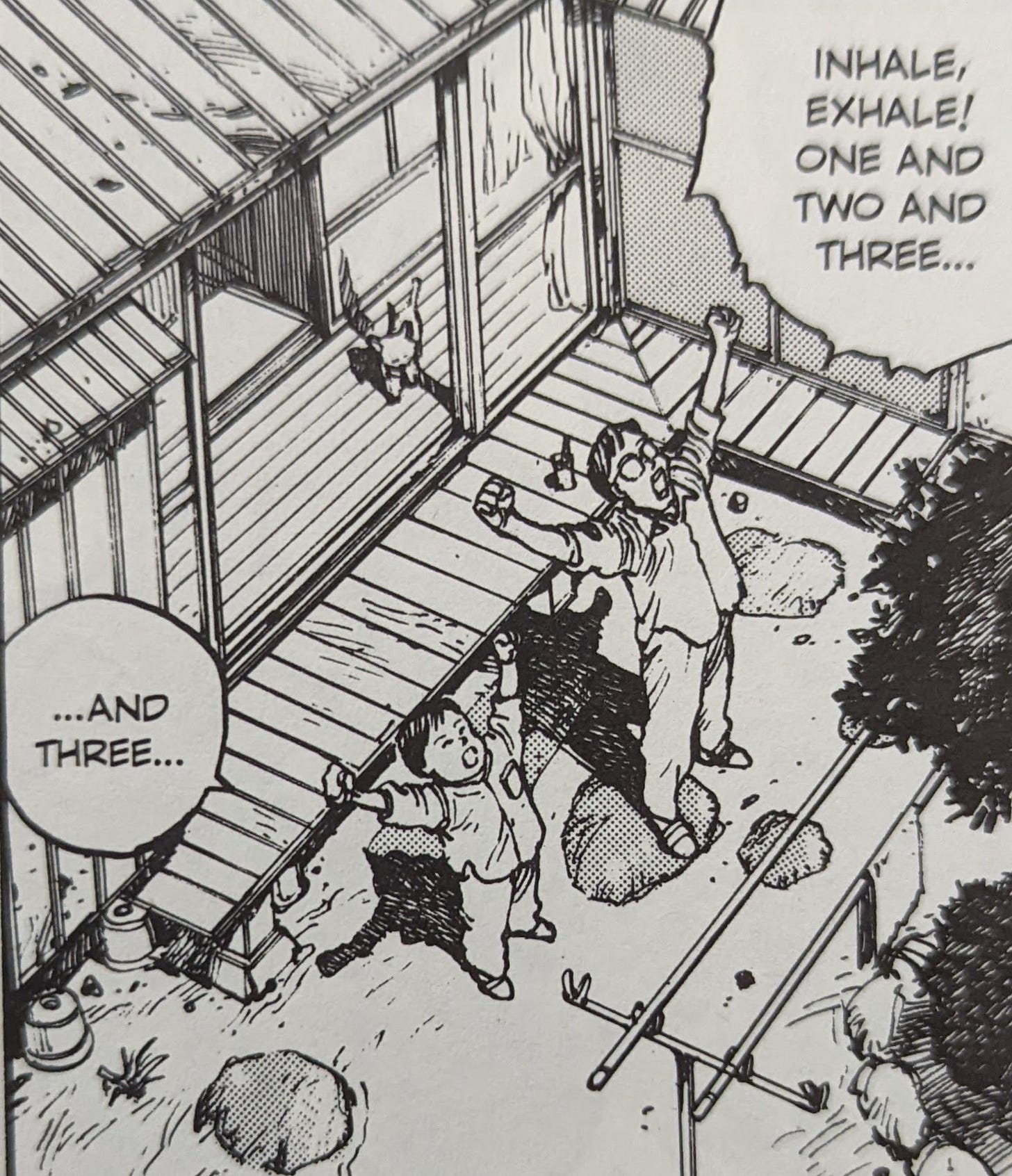Podcast: AKIRA Vol. 3, by Katsuhiro Otomo
Whenever Tetsuo's not on screen, all of the other characters should be asking "Where's Tetsuo?"
This week, we’re back to where it all began, as the gang luxuriates in the visual feast that is Katsuhiro Otomo’s AKIRA Volume 3. We’re gonna spoil you up front this week: Chip calls it his favourite volume of comics of all time. FOR REALS. Find out why by listening to this episode…!
And hey, for folks reading this in their email: We know this gets cut off very quickly. We’re verbose. You can always head to the website and read the web version, or just scroll to the end and click “view full email” in your email reader. Thanks for reading!
Listen and Subscribe to the Podcast:
Google | Apple | Stitcher | RedCircle | Amazon | Radio Public | PocketCast | Spotify
IN THIS EPISODE:
00:00 AKIRA volume 3
59:45 Shout-Outs! An art-book/sketchbook, manga about making manga with a romantic twist, and more about our first MSX manga, Okinawa by Susumu Higa.
AKIRA Volume 3
By Katsuhiro Otomo
Translation and English Adaptation by Yoko Umezawa, Linda M. York, Jo Duffy, and Stephen Paul
Lettering for the Kodansha edition by Evan Hayden
Edited by Ajani Oloye
Published in print by Kodansha
Show notes by Christopher Woodrow-Butcher and Deb Aoki. Audio editing by David Brothers.
Trigger warning: We mention some upsetting current events in Canada, and some upsetting events from the past that are weirdly resonant today, in this episode. It’s all in context, but maybe if you’re not in a great headspace you might wanna steer clear of this episode.
Before We Get Started:
As mentioned the last time we covered AKIRA, this, alongside Miyazaki’s Nausicaa of the Valley of the Wind, has one of the most complicated and lengthy publishing histories of any English language manga release. There are three main English language-editions: the first English editions published in 1988 featuring colored artwork from Steve Oliff, published by Marvel/Epic (and collected as graphic novels by Graphitti Designs); the first black and white edition, also “flipped” to read in the North American reading order, published by Dark Horse Comics in 2000 (a version of this edition was published by Kodansha as well); the most recent edition, the first ‘unflipped’ (Japanese reading order) edition in black and white and with a new translation, published by Kodansha exclusively as part of the AKIRA 35th Anniversary Edition Box Set in 2017.
We talk about all of these volumes more-or-less interchangeably, and also reference the AKIRA animated film (1986) quite a bit as well, as many events from the manga play out in the film slightly differently.
In short, you can follow this episode reasonably well without having listened to our episodes on AKIRA Vol 1 and AKIRA Vol 2, or having read the work, but it would be easier if you had. :)
Finally, as mentioned there's no digital edition of AKIRA, so all of the example images (republished here under fair use) are photographed, rather than screenshotted or scanned, so they're a little jank at times. Apologies in advance.
2:30 We’ve mentioned it before, but AKIRA Club is the official ‘art book’ of the AKIRA manga. It contains all of the material removed from the serialized installments of AKIRA (mostly title pages, covers, and promotional illustrations), as well as unpublished material, roughs, concept art, behind the scenes stories, and more. I’m pushing hard for it to be a not-technically-a-manga that we cover here on Mangasplaining, because I think it adds a lot to the overall experience of this story.
Like the hardcover ‘unflipped’ editions of AKIRA themselves, the AKIRA Club book was previously available as a stand-alone publication from Dark Horse, but is now only available as part of the AKIRA 35th Anniversary Box Set. We'll show an image or two from it down below.
2:45 We’ve mentioned DOMU by Katsuhiro Otomo quite a few times on the podcast. Poor Chip doesn’t recall it, but it is the one-volume graphic novel that Otomo created immediately preceding AKIRA.
As Deb mentions, the book is finally back in print in Japan thanks to a very large publishing project, OTOMO: THE COMPLETE WORKS, which aims to republish all of Katsuhiro Otomo’s book projects with a standard trade dress, and numbered based on their release order.
Of course, the books aren’t being released in their original release order, with volume 8, DOMU, having been released alongside volume 21, Animation AKIRA Storyboards Book 1, this past January in Japan. You can see the complete list of titles scheduled for the publishing project (alongside their release dates) at http://otomo-complete.com/list/index.html.
To date, no English edition (nor any international edition) has been announced for this project. People are antsy. Given his popularity in France, I’m kind of expecting that the international editions of this project will be revealed at the Festival International de Bande dessinée in Angouleme next month, but who knows?
3:28 Chonkers Ahoy. Volumes 4, 5, and 6 are all significantly thicker books than volumes 1-3. We reference this in the show notes and some of the behind the scenes stuff from previous episodes, but AKIRA is definitely a story that grew in the telling.
4:30 How do you sum up AKIRA? Well there’s 3 pages of recap at the start of each volume that seek to do just that. It’s dense.
6:00 I think it depends on what you mean by ‘setup’. We had some technical problems this episode that prevented me (Christopher) from digging in on this subject, but after reading it again and listening to the podcast, this volume really does start with ‘setup’. Please allow me to offer my opinion.
Volume 2 ends in the midst of a very explosive climax, volume 3 starts in that climax, and then proceeds through the narrative release of the climax. Volume 2's chase, conflicts, the back-and-forth, all of it, just sort of exhales and stops until about page 53 or 54 of volume 3. We get 50 pages checking in with all of the members of the cast, ‘resetting’ Kei and Kaneda back at the safe-house, showing the political infighting that The Colonel and Nezu need to deal with, but most importantly, we need this breather to set the stage for what comes next. We need 53 pages of setup, of scene-setting, new character introduction, establishing the new baseline of martial law and creepy spider robots. The chase for Akira is on pause while everyone regroups, and it isn’t until Sakaki (the new psychic girl introduced in this volume) finds Akira in the safehouse, and gets caught by Kaneda while in the midst of spiriting him away, that the chase starts up again.
In my ever-humble opinion, I think there’s 50 pages of setup, expertly told, at the beginning of this volume, and that’s a good thing. It makes what comes next so much better.
7:00 Spoilers: HE LIKED IT! He really liked it.
"Akira Volume 3 is maybe my favourite volume of anything I've ever read."
Chip Zdarsky
9:20 John Romita Jr. is an American comics creator, mostly known for his work on top superhero properties like The Amazing Spider-man, Uncanny X-Men, Superman, and Iron Man, and for co-creating the comics-multimedia project Kick Ass with writer Mark Millar. Romita’s a great comics artist.
10:00 Like David mentions, this IS a cool tank moment. And funny too. Not gonna spoil the whole joke here, but:
11:30 I couldn’t find an easy light-smear in the comics, but there are ten million gifs of the anime online that depict what we’re talking about here. It’s interesting that what seems like an effect tailor-made for anime actually got its start in the manga.
11:55 The slow zoom down as Kaneda is about to get shot, and then the ‘reverse’ shot, and then the aftermath. Absolutely a filmic technique, of ‘moving the camera’. The aftermath that Deb mentions in a moment, with the head duh-donking down the stairs, is good too. We’re about to dig into Otomo and his ‘filmic’ technique in a big way
13:30 Shooting in the narrow alleyways, and driving a tank through those narrow alleyways, is one of the best ‘farcical’ moments in the whole book. The whole thing feels like a madcap chase, which is an insane plot structure for a ‘serious sci-fi’ book, but it works so, so well. Akira is the McGuffin here, as he gets passed around from group to group. Anyway, as David mentions, this hallway/alleyway tank shot is really good. The little details of Kei and Chiyoko being knocked off their feet a little from the vibration and shockwaves is great too…
13:40 …as is the punch through the lifeboat, and the puke-attack that followed. Some great moments of levity that keep the series rolling, when it could easily become an overly grim and serious military story.
14:40 I’m anti-serialization, Chip is pro-serialization. Surprise, surprise. ;)
This is a deliberate misrepresentation of Chip's point, admittedly, but I'm leaving it in because it makes me smile.
15:40: Yeah, the mouse/rat character, right down to the big front teeth, if a sort of surprising move here. I think maybe every serious seinen story gets one ridiculous caricature? Nezu in AKIRA, that French noble from Vinland Saga. At least one of the serial killers from Golden Kamuy. But that said, here’s a shot of Nezu from AKIRA and from Nezumi-Otoko from Gegege no Kitaro side-by-side, and it’s pretty funny. I wonder if Otomo ever did any Kitaro tribute art?
16:40 Kaneda is weirdly capable sometimes.
18:00 David and Christopher both comment on how Tokyo feels like a real place in this volume, and the bits of everyday and humanity that are shown really, really reinforce just how dramatic the ending of this volume is. We’ll get to that in a second.
18:45 Okay, so we need to talk about this sequence, right at the end of volume 3, before the explosion.
It shows everyday people waking up, starting their mornings, oblivious to the action we’ve seen taking place over the evening depicted in the previous 200 pages. It shows that the Akira explosion has started, and it is growing. A broadcast tells people to stay in their homes and stay calm, it details a military coup. People do their morning exercises, have their breakfast, unaware of what’s unfolding nearby.
This is interspersed with the explosions, the shocked screaming faces of The Colonel, of Kaneda, Kei and Ryu, quick cuts between simultaneous moments, mundane and extraordinary. It's an incredibly powerful form of storytelling.
I first saw this technique used in an episode of The Simpsons, the episode Sideshow Bob’s Last Gleaming.
I couldn’t remember what episode it was, shout-out to Derek Halliday on Twitter for the help here! But like many (most) things in The Simpsons, I always assumed this was a reference to something else, but never knew what. Luckily, the Wikipedia for this episode correctly points us to the inspiration for this very unique filmic sequence: The 1962 Cold War thriller Fail Safe. The ending of the film (spoilers) features a very similar sequence, just before the theoretical explosion of a nuclear missile.
This clip is a little grainy and also really disturbing if you’re not ready for it, viewer discretion advised.
Anyway, this film sequence is almost certainly what Otomo is referencing in this moment, this double-page spread, because whatever else you need to know about Otomo, you should know that he was a voracious devourer of pop-culture, especially film. He talks a little bit about it in the interview in the upcoming book AKIRA: Art of Wall (we’ll discuss that in a moment), but yeah, it’s really clear where he drew inspiration from, and to see it so beautifully transformed into the comics page is quite a feat. By "transformed" of course, I mean that while the images on this spread are read in sequence, like a film, they are also produced simultaneously, unlike a film. As your eye scans the page, you’ll catch Kaneda’s horrified reaction several times, your eyes will dart back and forth from scene to scene and back again, the entire split second of the explosion broken down into a near-eternity of simultaneous moments, it’s good, good fucking comics.
And it isn’t in the AKIRA movie. Transitioning a filmic technique from a film to… another film (albeit animated) isn’t nearly as revolutionary as transitioning between completely different mediums, and the AKIRA animated film handles this same sort of idea differently, so much so that you’d never know there was an homage in the first place. It’s one of the many reasons why reading this manga is so, so worthwhile.
20:50 Back to our favourite panels and details, Chip and David point out how excellently conveyed, and then mirrored, the sequences of Kei and Kaneda coming up out of the sewers through the manholes are. Here’s those two sequences.

22:10 Chip mentions ‘dutch angles’, which is another filmic technique (photography and cinema) where the horizon of a shot is ‘tilted’ so that it doesn’t run parallel to the bottom of the camera frame. This creates a dynamism and makes a sequence feel more energetic, sometimes tense or uneasy or anxious. It’s still used, albeit more sparingly, in more-or-less every superhero movie, among other genres of film. The Batman TV show did, in fact, use it to a near-ludicrous degree.
23:30 Yeah, almost everyone likes dogs, which is why those robots from Boston Dynamics are shaped like dogs. Still freaks people out, but if they looked like spiders, I’m pretty sure the internet would riot… although this video gives me spider-vibes.
23:50 So yeah, the spider-bots, the peacekeeping robots, the “Caretakers” are really amazing designs.
I was a bit unsure of this, and I can’t find verification online at the moment, but I’m pretty sure that I heard manga artist Masamune Shirow, creator of Ghost in the Shell, gave credit to Otomo’s ‘Caretakers’ for inspiring the designs of his popular Tachikoma robots from GitS. I can… definitely see the resemblance.
This is unsourced, just something I remember coming across as I read hundreds of thousands of words on the internet over the years, feel free to sound off in the comments if I’ve got it wrong.
24:00 Chip makes a great observation, that the shape of the council chamber gives off the same sort of spider-vibes as the caretaker robots themselves.
24:30 Chip also points out how stunning this staircase panel is, and the choice to make The Colonel look very small and insignificant against the majesty of the governmental building. Fantastic environmental storytelling.
25:00 Shout-out to Pepe Larraz, illustrator on various Marvel Comics, particularly their X-Men line of books. He’s a great illustrator!
25:35 An example of what David’s saying here, where in Otomo’s action sequences, it’s rarely just a series of actions of one character. There’s so-often a moment where we cut to the person about to be affected by the action, right before it happens. It’s a great storytelling trick.
26:30 Deb mentions page 198-199, as being two pages with many panels (7 a-piece), but still being very, very easy to read and featuring some great, interesting angles.
27:45 This has been a theme since we first started talking about the book, how female characters are treated in this series. The book really starts off as a boy’s adventure (or at least, a juvenile young-man’s adventure), with Kaneda, Tetsuo, Ryu, The Colonel, and Nezu being central characters. In AKIRA Volume 2, this begins to shift, and finally this volume moves Chiyoko to the forefront, gives a ton of time to Lady Miyako and her assassin squad. Kei is pretty bad-ass this time out too. The book definitely evolves over time.

In the film, Kei is a psychic stand-in Kiyoko, and Lady Miyako and Chiyoko are nearly absent, owing to it being largely an adaptation of the first 2-3 volumes, and some serious compression. It's a very different take.
30:00 I think this is pretty cool, that David had to read AKIRA Volume 3 from the ‘original’ full color comics that were the first versions of the stories that he read. It’s why I’ve still got my original issues of The Invisibles.
“Every version of AKIRA that I have is differently beautiful.”
David Brothers
31:17 The color version of the pages where Takashi is shot by Nezu, as he’s slowly falling, are gorgeous in the original black and white. But Oliff dropping out all of the colour in this sequence, creating a ‘spot color’ effect, is really something else.
32:05 Briefly, since I’ve mentioned Shin-Godzilla before, it’s a contemporary take on the Godzilla franchise by Neon Genesis Evangelion creator Hideo Anno, which is sort of framed like Japanese cultural ideologies in facing off against the Godzilla threat. Building committees, studying problems, executing multi-pronged solutions that would be impossible without everyone working together, etc. etc.. The works only get gummed up when someone acts out of self-interest, rather than group interest. It’s a VERY interesting work, I can’t wait to see how that ideology will play out in his adaptation of Kamen Rider, which is the ultimate lone-wolf sort of story.
32:20 King Shit of Fuck Mountain. For the record.
And “Now you’re king of the mountain but it’s all garbage.” is a reference to the anime, not upcoming manga volumes. I don’t think this line is in the manga, just FYI. I guess we’ll see, though!
36:45 The Japanese student protests are a subject we’ve talked about a little here before. They mirror some of the protests happening at the time (1968-1969) in France and America. It’s a big subject to get into, but to say that it deeply influenced manga for many years, and especially creators of Otomo’s generation (Otomo made his manga debut in 1973). Works like Sanpei Shirato’s Kamui Den, which ran in Garo magazine, were pretty influential in the student movement, for example. I’m sure with very little effort someone could draw a few direct lines to Otomo’s early short stories from the work of the student movement. The anti-authoritarian spirit certainly lives on in this particular work.
38:30 There are conflicting reports of what the new AKIRA anime will be. This report from EW says that it will be ‘a continuation of the world of AKIRA, whereas other news sources from the time say it will be a reboot, or a new adaptation of the manga into television anime.
Regardless, there has been no word on this happening since it was first announced in… July 2019. Ah, perhaps everyone involved has had their attention focused… elsewhere.
42:55 I hadn’t seen the animation for Drifting Dragons (though I like the art of the comics alright), and so I was bracing myself, but the animation doesn’t look as bad as I was expecting based on Deb's reaction. It’s still far lesser than the best sort of hand-drawn, or at least computer-assisted, animation. It’s just not a patch on Ghibi’s flying sequences in this same genre, for example, but comparing film and television isn’t terribly fair. Still, I could see how it would be very distracting.
43:15 Katsuhiro Otomo is 67, and was born in 1954.
44:19 Deb mentions the very fun newspaper pages in the back of volume 3.. Except they don’t appear to be in either the Marvel or Dark Horse editions! For all the fans reading along at home, here’s a reasonably-sized photo of what these pages look like. There’s a number of articles written in the world of AKIRA, and a fourth-wall breaking story about Otomo starting work on AKIRA volume 4.
Maybe most interesting? This double-page spread, a piece of advertising artwork essentially, also doesn’t seem to appear in AKIRA Club…? This might be the first time these two pages have been translated into English (The Japanese version with different text placement is also included, but not shown here). Another reason to love that box set.
45:45 Yeah, Masaru looks like the late, great comedian Louie Anderson. Rest in Peace.
46:15 I thought about including the rest of the gunshot sequence (the pages before and after the color page above), but I don’t want to cross the line with the pages that we’re excerpting here. But it really is another masterful sequence, I think Deb points out a great reference (that feels accurate, given how many references are packed into this volume in particular). So no images, get your copies of AKIRA Volume 3 (or Marvel Epic Issue #16) out and read along.
49:00 I’m not super up on the Newsboy Legion, and after reading the wiki, I feel like I still don’t entirely get it. https://en.wikipedia.org/wiki/Newsboy_Legion
49:19 As seen in our header image!
50:00 So yeah, we have to talk about this epic double page spread from the AKIRA Club art book, comparing the page-order for the apocalypse sequence of AKIRA as it appeared in the serialization (complete with interspersed title pages), with the final version as it appears in the collected volume 3. The amount of work that’s happening here on multiple levels, alongside Otomo’s own humility/sadness at his work on what might be the most technically excellent comics sequence of all time.
53:30: Deb mentions some rather risque doujinshi, including a Buddha X Jesus slash pairing among other questionable works. Gotta love the fan press. ;)
54:30: AKIRA Art of Wall: Conflict-of-interest-alert: Christopher (hi!) was an editor on the English edition of the forthcoming art book AKIRA: Art of Wall. The book contains three massive 'scrolls' of collages that were created from Otomo's work on AKIRA by artist Kosuke Kawamura, printed as long accordion-fan scrolls that fold out, and it's a heck of a project. As cool as this will look on your shelf (or the scrolls will look displayed in your home), the star of the show for me are the really great behind-the-scenes interviews with Otomo about AKIRA, and his work in general. I loved reading and editing these interviews, and I think Otomo fans should definitely consider picking this one up if they have a spare hundred and thirty bucks lying around.
59:14: THE BREAK! Thanks for listening through!
59:34 SHOUT OUTS
David shouts-out Sketch by Katsuya Tarada, published by PIE International. Previously known as “Rakugaking” in its import days, this humongous 512 page sketch collection is pure artistic inspiration between two covers. Available now from PIE.
Deb shouts-out the manga The Transcendent One-Sided Love of Yoshida the Catch, a romance with manga with a twist by creator Shizuki Fujisawa. The title is currently available as a digital release from Kodansha.
Christopher offers up a prompt to go check out the digital serialization of Okinawa by Susumu Higa, on the MSX: Mangasplaining Extra newsletter, despite the fact that it’s pretty harrowing at times. Chapters 2 and 3 are available for paid subscribers now.
And that’s an episode of Mangasplaining! We’ll see you next week with our season 2 wrap-up episode, where we take a look at many of the books we’ve covered over the past 6 months.
Thanks so much for reading and listening and supporting Mangasplaining! You can find a comics and manga specialty retailer near you at Comicshoplocator.com.
You can also check out our new publishing endeavour, Mangasplaining Extra, at http://www.mangasplainingextra.com
And check out D.A.D.S. on Spotify, he made our cool theme music for us.







